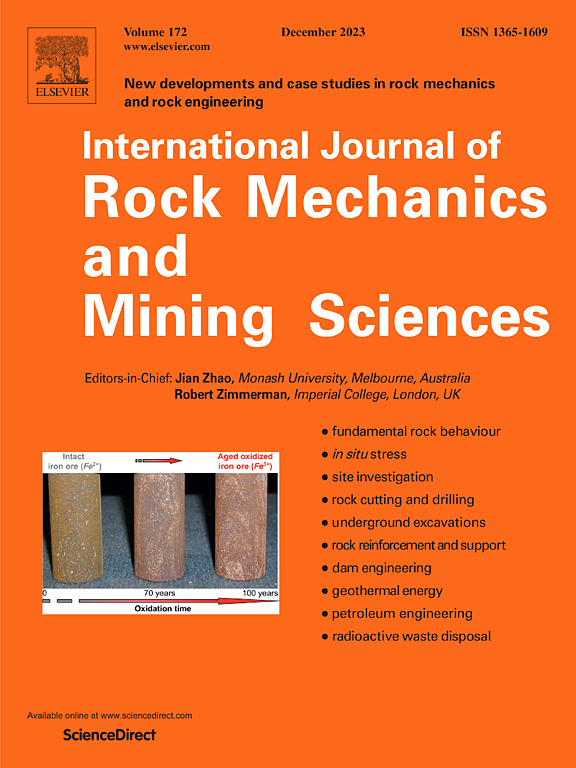新型碰撞系统中圆柱形岩石试样的破碎特性及能量分量
IF 7
1区 工程技术
Q1 ENGINEERING, GEOLOGICAL
International Journal of Rock Mechanics and Mining Sciences
Pub Date : 2025-04-19
DOI:10.1016/j.ijrmms.2025.106114
引用次数: 0
摘要
采用最近报道的一种新的岩石碰撞试验方法,对三种岩石的27个圆柱形岩石试件进行了试验。用摄像机记录碰撞过程,用激光仪测量每个试样的速度,用应变片测量传递到透射杆上的应力波能量,并在碰撞试验后收集、称重和筛分每个试样的所有碎片。结果表明:(1)所有岩石试样都成功地从新碰撞系统的入射杆中释放出来,证实了新碰撞方法在以13 ~ 39 m/s速度飞行的圆柱形试样碰撞试验中是成功的。(2)所有岩石试样均破碎成大量颗粒。(3)比输入能量(单位体积岩石的输入能量)在0.48 ~ 4.4 MJ/m3之间变化。(4)传递给输送杆的能量占总输入能量的0.4% ~ 1.8%。(5)飞片携带的平移动能和旋转动能分别等于或小于总输入能量的7.7%和6.9%。(6)如果只考虑动能和传递能,忽略其他未知能量,碎裂所消耗的能量高达输入能量的83.6%。(7)比输入能量是影响岩石破碎的重要因素之一,比输入能量越大,破碎越好(细),反之亦然。(8)岩石阻抗是影响岩石破碎的另一个重要因素。在近似恒定的比输入能量下,阻抗越小的岩石试样破碎性越好,反之亦然。(9)碰撞试验中透射杆测得的波长平均为弹性理论计算波长的13倍。本文章由计算机程序翻译,如有差异,请以英文原文为准。
Fragmentation characteristics and energy components of cylindrical rock specimens in a novel collision system
By means of a novel experimental method for rock collision reported recently, a total of 27 cylindrical rock specimens from three rocks were tested. The collision process was filmed by a camera, the velocity of each specimen was measured by a laser instrument, the stress wave energy transferred to the transmitted bar was measured by the strain gauges, and all fragments of each specimen were collected, weighed, and sieved after collision tests. The results showed that: (1) all rock specimens were successfully released from the incident bar of the new collision system, confirming that the new collision method is successful for collision tests using cylindrical specimens flying with a velocity of 13–39 m/s. (2) All rock specimens were fragmented into numerous particles. (3) Specific input energy, defined as the input energy per unit volume of rock, varied from 0.48 to 4.4 MJ/m3. (4) The energy transferred to the transmitted bar was 0.4–1.8 % of the total input energy. (5) The translational kinetic energy and the rotational kinetic energy carried by the flying fragments were equal to or less than 7.7 % and 6.9 % of the total input energy respectively. (6) The energy used in fragmentation was up to 83.6 % of the input energy if only the kinetic and transmitted energies were considered while other unknown energies neglected. (7) Specific input energy was one of most important factors influencing rock fragmentation, and larger specific input energy resulted in better (finer) fragmentation, and vice versa. (8) Rock impedance was another important factor effecting rock fragmentation. At an approximately constant specific input energy, a rock specimen having smaller impedance yielded better fragmentation, and vice versa. (9) The wavelength measured in the transmitted bar during the collision tests was on average 13 times of the calculated wavelength based on elastic theory.
求助全文
通过发布文献求助,成功后即可免费获取论文全文。
去求助
来源期刊
CiteScore
14.00
自引率
5.60%
发文量
196
审稿时长
18 weeks
期刊介绍:
The International Journal of Rock Mechanics and Mining Sciences focuses on original research, new developments, site measurements, and case studies within the fields of rock mechanics and rock engineering. Serving as an international platform, it showcases high-quality papers addressing rock mechanics and the application of its principles and techniques in mining and civil engineering projects situated on or within rock masses. These projects encompass a wide range, including slopes, open-pit mines, quarries, shafts, tunnels, caverns, underground mines, metro systems, dams, hydro-electric stations, geothermal energy, petroleum engineering, and radioactive waste disposal. The journal welcomes submissions on various topics, with particular interest in theoretical advancements, analytical and numerical methods, rock testing, site investigation, and case studies.

 求助内容:
求助内容: 应助结果提醒方式:
应助结果提醒方式:


